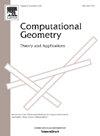莫尔斯匹配的参数化不可逼近性
IF 0.4
4区 计算机科学
Q4 MATHEMATICS
Computational Geometry-Theory and Applications
Pub Date : 2024-10-30
DOI:10.1016/j.comgeo.2024.102148
引用次数: 0
摘要
我们从不可逼近性和参数化复杂性的角度研究了临界简约数最小化问题。我们首先证明了 Min-Morse Matching 在 2log(1-ϵ)n因子范围内的不可逼近性。我们的第二个结果表明,Min-Morse Matching 在标准参数方面是 W[P]-hard 的。从积极的方面看,我们为 2 维复数上的 Min-Morse Matching 提供了系数为 O(nlogn) 的近似算法,而对于更高维的复数,我们还不知道有这样的算法。最后,我们设计了具有极少临界简约的离散梯度,适用于从柯斯达-法伯随机复数模型相当广泛的参数值范围中抽取的典型实例。本文章由计算机程序翻译,如有差异,请以英文原文为准。
Parameterized inapproximability of Morse matching
We study the problem of minimizing the number of critical simplices from the point of view of inapproximability and parameterized complexity. We first show inapproximability of Min-Morse Matching within a factor of . Our second result shows that Min-Morse Matching is -hard with respect to the standard parameter. Next, we show that Min-Morse Matching with standard parameterization has no FPT approximation algorithm for any approximation factor ρ. The above hardness results are applicable to complexes of dimension ≥2.
On the positive side, we provide a factor approximation algorithm for Min-Morse Matching on 2-complexes, noting that no such algorithm is known for higher dimensional complexes. Finally, we devise discrete gradients with very few critical simplices for typical instances drawn from a fairly wide range of parameter values of the Costa–Farber model of random complexes.
求助全文
通过发布文献求助,成功后即可免费获取论文全文。
去求助
来源期刊
CiteScore
1.60
自引率
16.70%
发文量
43
审稿时长
>12 weeks
期刊介绍:
Computational Geometry is a forum for research in theoretical and applied aspects of computational geometry. The journal publishes fundamental research in all areas of the subject, as well as disseminating information on the applications, techniques, and use of computational geometry. Computational Geometry publishes articles on the design and analysis of geometric algorithms. All aspects of computational geometry are covered, including the numerical, graph theoretical and combinatorial aspects. Also welcomed are computational geometry solutions to fundamental problems arising in computer graphics, pattern recognition, robotics, image processing, CAD-CAM, VLSI design and geographical information systems.
Computational Geometry features a special section containing open problems and concise reports on implementations of computational geometry tools.

 求助内容:
求助内容: 应助结果提醒方式:
应助结果提醒方式:


